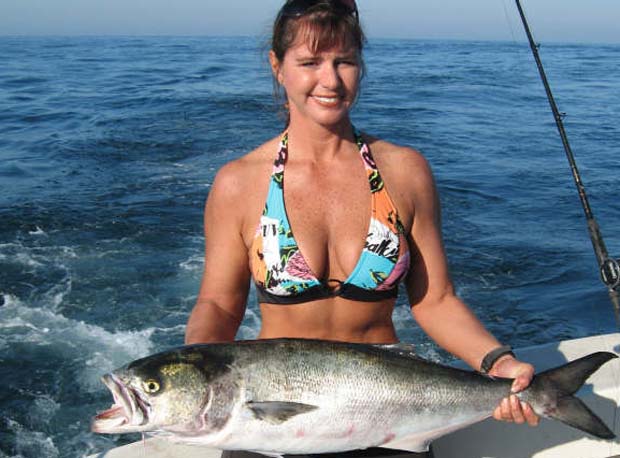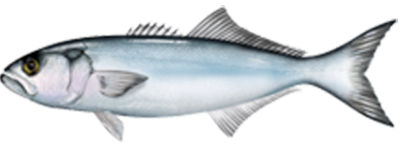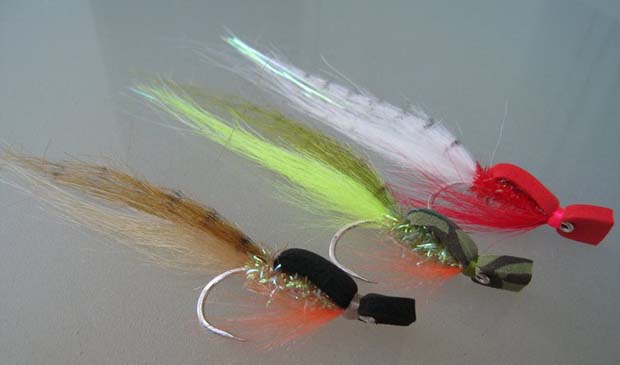The Bluefish, Pomatomus saltatrix
[dropcap]C[/dropcap]olor is steel blue or dark green above, shading to silvery white below. Dark spot usually shows at base of pectoral fin. Large mouth with prominent razor sharp teeth. Yellow eyes and very large head. Forked tail. Strong swimmer. Bluefish are distributed throughout the world. They can live to about 10 years.
There’s only one way to put it when it comes to bluefish, they’re vicious. They’ll eat their young. When they catch a prey, they’ll bite its tail off, then start eating the head. They will eat to full, then throw-up and keep-on killing. The scene after a large school of bait-fish has been attacked by a school or schools of bluefish will show water with oily film on it made by chunks of fish parts. The bird will be there.
But as a game fish it doesn’t get any better, they’ll twist like a spinner shark, perform airborne gymnastics like a tarpon and fight harder than you can imagine. Each season, when they’re in South Florida and I catch my first of the season, I’m always stunned by their power. If the blues are around and it’s one of those days, make sure you have lots and lots of flies. They can destroy a $5 fly on one hook-up.
Nicknames: racers, gators, choppers, greasers, snappers and cocktails (juveniles) and a whole bunch more.
More about blues
Blues are not on every anglers radar screen for more than one reason. One, they can easily remove a digit; two, they destroy flies and lures faster than a politician can lie; three, they bite right through mono and lastly, most people feel that bluefish, especially the big boys, do not have decent eating qualities. That’s not true of the small baby blues. Eaten the day they are caught, they’re pretty good and have lots of omega 3.
There’s a weirdness
In mid to late May and sometimes into June the blues will haunt the flats of Long Island, New York – arriving particularly thin. Some fish biologists speculate they don’t eat on their run north. Peculiarly, when blues show on the flats they don’t eat so fooling one means annoying it so it will attack to kill. Any number of flies fit the bill (more on that in coming feature). On the flats blues will spook easily. You have to wade or be poled in for a shot. If you can’t cast well, you’re decidedly doomed. If you use a wire bite guard your chances of spooking every fish you cast to is very high. Use 40- or 50-pound test mono and hope not to get bitten off.
Here’s the weirdness, on the flats in pods of slightly less than 10 to up to say 20, they’ll exhibit what is called daisy-chaining – going in a circle nose to tail. The latter believed to be a pre-spawn flirt, but they won’t spawn until they’re way offshore.
When they return in the fall – post their flats engagement, they’ll steadily come south from their most northern reaches – arriving in say Montauk in late September / early October. They’ll be there for a month and a half (approximately) and just keep on trucking southward – following the bait.
Wintering blues
Blues here (South Florida) average about 3-pounds, but sometimes a school of baby blues will come along and they’ll be a little more than 1-pound. However, later in the spring, catches of blues will in the 6- or 7-pound range are very probable, especially around inlets, passes and jetties on both coasts. In big run years blues can be caught up to 20-pounds. I’ve never caught one bigger than 15-pounds.
Juveniles, until sexually mature – about two years old, will inhabit the back bays along the coasts. When mature they’ll head for deeper water.
Oddly, if you get into a school of blues and you catch one that’s 10-pounds, the entire school will be just about the same weight. Too, like cobia and dolphinfish – catch one and the pod will stay in attendance.
International Game Fish Association
IGFA world record is 31-pounds, 12-ounces caught in North Carolina. That’s All-tackle and line class. The biggest bluefish are almost exclusive to North Carolina.
The fly rod records for blues are again dominated by catches in North Carolina. Here are the states’ IGFA records for fly fishing: North Carolina > 19-pounds, 12-ounces on 16-pound test line; Massachusetts > 18-pounds, 6-ounces on 8-pound test line; Connecticut > 16-pounds, 3-ounces on 20-pound test line and Virginia > 19-pounds, 4-ounces on 12-pound test line.









